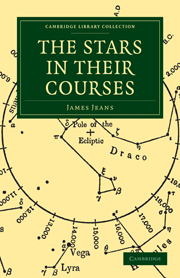Book contents
IV - Weighing and Measuring the Stars
Published online by Cambridge University Press: 05 October 2010
Summary
We have already seen how important the force of gravitation is, both to astronomy and ourselves. It keeps the moon tied to the earth, and maps out the paths of all the planets and other members of the sun's family; it raises the tides in our oceans, and, we believe, raised those far greater tides in the sun which, some 2000 million years ago, brought our earth, and so ultimately ourselves, into being. Finally, it keeps us alive, by making the earth stay near the sun instead of running away into the icy depths of space.
Let us try to understand a little more as to what this force is.
The Force of Gravitation
No man can lift a ton weight; he is prevented by the force of gravitation—or gravity, as we usually call it when it acts on earth. This pulls the weight to the ground, and proves too strong for him.
Again, we find it impossible to throw a cricket ball for a mile; we are prevented by the same force, which continually pulls the ball towards the ground, and invariably succeeds in getting it down before it has travelled a mile. We can easily throw the ball out of our hands at twenty miles an hour, and if gravity did not draw it earthward, it would cover a mile every three minutes, and after a year it would be far out in space, 175,000 miles away from the earth.
- Type
- Chapter
- Information
- Stars in Their Courses , pp. 68 - 85Publisher: Cambridge University PressPrint publication year: 2009First published in: 1931

